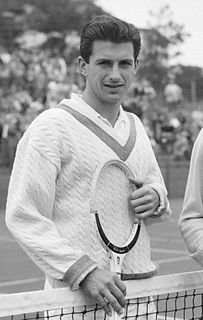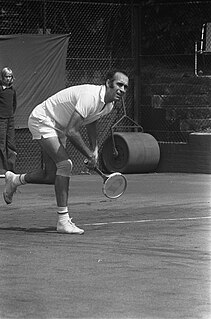
Rodney George Laver is an Australian former tennis player. Laver was the world number 1 ranked professional in some sources in 1964, in all sources from 1965 to 1969 and in some sources in 1970, spanning four years before and three years after the start of the Open Era in 1968. He was also ranked the world number 1 amateur in 1961 by Lance Tingay and 1962 by Tingay and Ned Potter.

Lewis Alan Hoad was an Australian tennis player whose career ran from 1950 to 1973. Hoad won four Major singles tournaments as an amateur. He was a member of the Australian team that won the Davis Cup four times between 1952 and 1956. Hoad turned professional in July 1957. He won the Kooyong Tournament of Champions in 1958 and the Forest Hills Tournament of Champions in 1959. He won the Ampol Open Trophy world series of tournaments in 1959, which included the Kooyong tournament that concluded in early January 1960. Hoad's men's singles tournament victories spanned from 1951 to 1971.

Kenneth Robert Rosewall is an Australian former world top-ranking amateur and professional tennis player. He won a record 23 tennis Majors in singles, including 8 Grand Slam singles titles and, before the Open Era, a record 15 Pro Slam titles; overall, he reached a record 35 Major finals. He won the Pro Grand Slam in 1963. Rosewall won a record 24 major men's doubles titles. He won 9 grand slam titles in men's doubles with a career men's doubles grand slam and also won 15 Pro Slam men's doubles titles.

Ricardo Alonso "Pancho" González, known sometimes as Richard Gonzales, was an American tennis player. He won 15 major singles titles, including two U.S. National Singles Championships in 1948 and 1949, and 13 Professional Grand Slam titles. He also won three Tournament of Champions professional events in 1957, 1958, and 1959. He was ranked world amateur No. 1 in 1948 by Ned Potter and in 1949 by Potter and John Olliff. Gonzales was a prominent professional champion in the 1950s and 1960s, winning world professional championship tours between 1954 and 1961; he was ranked world No. 1 professional in some rankings between 1952 and 1961.

Francisco Olegario Segura, better known as Pancho "Segoo" Segura, was a leading tennis player of the 1940s and 1950s, both as an amateur and as a professional. He was born in Guayaquil, Ecuador, but moved to the United States in the late 1930s. Throughout his amateur career he was listed by the USTA as a "foreign" player resident in the U.S. As a professional player, he was referred to as the "Ecuadorian champ who now lives in New York City". After acquiring U.S. citizenship in 1991 at the age of seventy, Segura was a citizen of both countries, although he never represented the U.S. in tennis competition.

Francis "Frank" Arthur Sedgman is an Australian former world No. 1 tennis player. Over the course of a three-decade career, Sedgman won five Grand Slam singles tournaments as an amateur as well as 22 Grand Slam doubles tournaments. He is one of only five tennis players all-time to win multiple career Grand Slams in two disciplines, alongside Margaret Court, Roy Emerson, Martina Navratilova and Serena Williams. In 1951, he and Ken McGregor won the Grand Slam in men's doubles. Sedgman turned professional in 1953, and won the Wembley World Professional Indoor singles title in 1953 and 1958. He also won the Sydney Masters tournament in 1958, and the Melbourne Professional singles title in 1959. He won the Grand Prix de Europe Professional Tour in 1959.

John Albert Kramer was an American tennis player of the 1940s and 1950s. He won three Grand Slam tournaments. He led the U.S. Davis Cup tennis team to victory in the 1946 and 1947 Davis Cup finals. Kramer won the U.S. Pro Championship at Forest Hills in 1948 and the Wembley Pro Championships in 1949. He won world professional championship 2-man tours in 1948, 1949/50, 1950/51, and 1953. He was ranked world No. 1 amateur player for 1946 by Pierre Gillou, Harry Hopman and Ned Potter. He was ranked World No. 1 amateur player for 1947 by John Olliff, Pierre Gillou and Ned Potter. In 1948 he was ranked the U.S. No. 1 professional in the USPLTA contemporary rankings for U.S. pro tennis play.
Before the advent of the Open era of tennis competitions in April 1968, only amateurs were allowed to compete in established tournaments, including the four majors. There was no prize money and players were compensated for travel expenses only. However many top tennis players turned professional to play legally for prize money in the years before the open era. They played in separate professional events, mostly on tours involving head-to-head competition, but also in professional tournaments as the biggest events on the pro tour. Professional tournaments, in particular the professional majors, usually only had a men's draw.

Marion Anthony Trabert was an American amateur world No. 1 tennis champion and long-time tennis author, TV commentator, instructor, and motivational speaker.

Henry Christian Hopman CBE was an Australian tennis player and coach.

Ashley John Cooper AO was an Australian tennis player who played between 1953 and 1968. He was ranked as the world's No. 1 amateur player during the years of 1957 and 1958. Cooper won four singles and four doubles titles at Grand Slam tournaments. He won three of the four Grand Slam events in 1958. He turned professional in 1959. Cooper won the Slazenger Professional Championships tournament in 1959. He won the Grand Prix de Europe professional tour of Europe in 1960. Cooper won the European Cup professional tour of Europe in 1962. He retired from tennis play at the end of 1962 due to injury.

Andrés Gimeno Tolaguera was a Spanish tennis player. His greatest achievement came in 1972, when he won the French Open and became the oldest first-time Grand Slam champion in the Open era at 34 years of age.

Malcolm James Anderson MBE is a former tennis player from Australia who was active from the mid-1950s to the early 1970s. He won the singles title at the 1957 U.S. National Championships and achieved his highest amateur ranking of No. 2 in 1957. He became a professional after the 1958 season and won the Wembley World Professional Tennis Championships in the 1959 season. He was runner-up at the 1972 Australian Open championships.
World number 1 ranked male tennis players is a year-by-year listing of the male tennis players who were ranked as world No. 1 by various contemporary and modern sources. The annual source rankings from which the No. 1 players are drawn are cited for each player's name, with a summary of the most important tennis events of each year also included. If world rankings are not available, recent rankings by tennis writers for historical years are accessed, with the dates of the recent rankings identified. In the period 1948–1953, when contemporary professional world rankings were not created, the U.S. professional rankings are cited.
The U.S. Pro Tennis Championships was the oldest professional tennis tournament played until its final year of 1999 and is considered to have been a professional major from 1927–1967 until the advent of Open Era. In 1953, 1955, 1956, and 1960, the Cleveland World Pro had a women's draw, with Pauline Betz winning the first three of these, and defeating the reigning U.S. women's champion Doris Hart in the 1956 final. Althea Gibson defeated Pauline Betz in the 1960 women's final.

Ampol Limited is an Australian petroleum company headquartered in Sydney, New South Wales. Ampol is the largest transport energy distributor and retailer in Australia. It also operates in New Zealand through its subsidiary Z Energy.
Since 1990, the biggest events in men's tennis have been the four Grand Slam tournaments, the ATP Finals and the ATP Masters tournaments, in addition to the Grand Slam Cup between 1990–99. From 1983 to 1990, men's tennis had a very strong tradition and clear hierarchy of tournaments: the Grand Slam tournaments, including Wimbledon, the US Open, the French Open, and the Australian Open; the season-ending Masters Grand Prix; and the Davis Cup. Before 1983, however, and in particular before the start of the Open Era in 1968, the hierarchy of professional tournaments changed virtually every year. For example, in 1934, the U.S. Pro was a high-class tournament with all the best players, but just two years later, the same tournament was ordinary because only professional teachers entered the event.
The Masters Pro was a tournament open to men's tennis professionals. It was held between 1956 and 1959 and again between 1964 and 1965. The Ampol Masters at White City, Sydney was held in 1958. The tournament was played in a round robin format instead of the usual knockout competition on each of the six occasions that it was played in Los Angeles, and a knockout format when played at Sydney in 1958. At the 1964 and 1965 editions the round robin stage was followed by a semifinal and final round. The event was played on hard cement tennis court's at the L.A. Tennis Club, and on grass in 1958 at White City, Sydney.
The Australian Pro was a men's professional tennis tournament held in 1954. It was billed as the Australian Professional Championships. In many later years, separate pro events were held in various Australian state capitals. From 1957 to 1959 Tournament of Champions events were held in Australia. The Ampol Masters was held in 1958 at White City, Sydney.
For many years before the Open Era of tennis in 1968, the usual format for the handful of touring tennis professionals was a series of two-man one-night stands across the United States and often in other countries as well. The most notable of these tours were the "World Series" or "World Professional Championships", in which the reigning world champion went head-to-head against a challenger, most often the leading amateur of the previous year who had just turned pro. Promoters would attempt to sign the leading amateur to a contract with a minimum guarantee against a percentage of gate receipts, making a similar type of deal with the reigning professional champion and sometimes giving smaller percentages to undercard players. The winners of the tours were described as being the "world champion".












